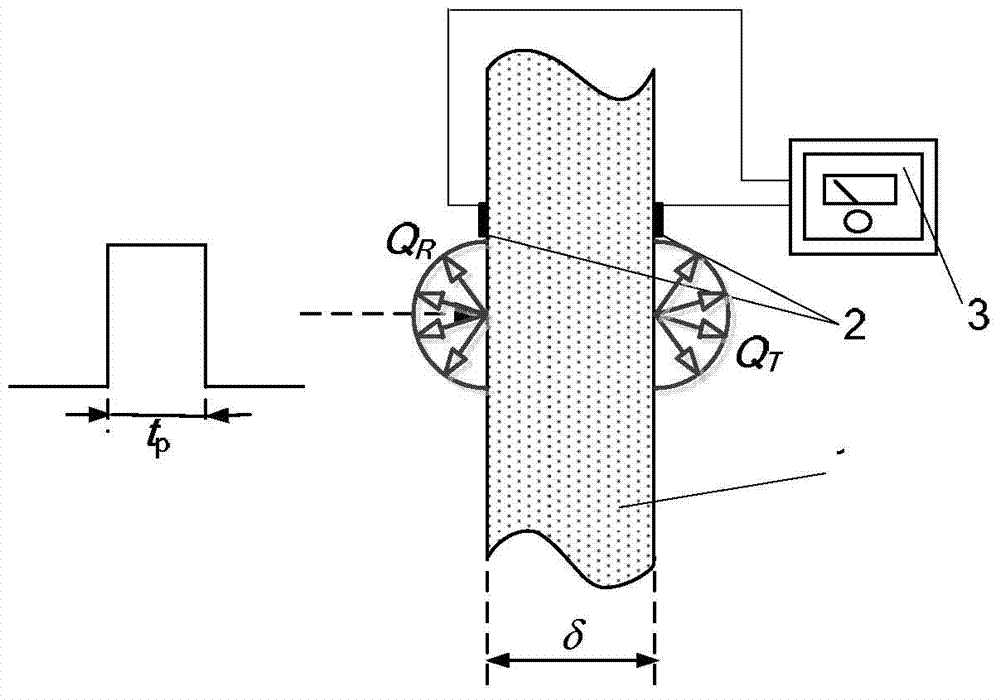Method for measuring thermophysical parameters of translucent material with transient photothermal signals generated by heating pulse lasers
A technology of translucent materials and thermophysical parameters, which is applied in the direction of material thermal development, color/spectral characteristic measurement, scattering characteristic measurement, etc., and can solve the problems of complex measurement system and low measurement accuracy
- Summary
- Abstract
- Description
- Claims
- Application Information
AI Technical Summary
Problems solved by technology
Method used
Image
Examples
specific Embodiment approach 1
[0024] Specific Embodiments 1. A method for measuring the absorption coefficient, scattering coefficient and thermal conductivity of translucent materials using transient photothermal signals generated by pulsed laser heating described in this embodiment. The specific operation steps of the method are:
[0025] Step 1. Make the translucent material to be tested into a flat specimen with a thickness of δ, aim the laser at the center of the left side of the specimen, and make the laser direction perpendicular to the surface of the specimen, and connect two thermocouples to measure the temperature The thermocouple probe on the instrument is fixed on the left and right sides of the specimen;
[0026] Step 2. Turn on the pulse laser to heat the left surface of the specimen with a pulse. At the same time, use a thermocouple thermometer to measure synchronously to obtain the temperature change of the incident surface of the laser on the left side with time as T w1 (t), the change of ...
specific Embodiment approach 2
[0036] Specific embodiment 2. This embodiment is a further description of the method for measuring the absorption coefficient, scattering coefficient and thermal conductivity of translucent materials by using transient photothermal signals generated by pulsed laser heating described in specific embodiment 1. For semi-transparent For transparent materials, the time scale of the heat conduction process is much larger in magnitude than the radiation relaxation time scale, so the calculation of the temperature response of the measured material wall and the hemispherical reflected radiation signal and hemispherically transmitted radiation signal in step 3 is essentially a transient state A coupled solution problem for the heat conduction differential equation and a steady-state radiative transfer equation. Other steps are the same as the specific implementation of Trial 1.
specific Embodiment approach 3
[0037] Specific Embodiment 3. This embodiment is a further description of the method for measuring the absorption coefficient, scattering coefficient and thermal conductivity of translucent materials using transient photothermal signals generated by pulsed laser heating described in Embodiment 1. Step 3 The algorithm for the inverse problem described in is implemented by the improved simulated annealing-stochastic particle swarm optimization algorithm (SA-SPSO). Other steps are the same as the specific implementation of trial one or two.
PUM
 Login to View More
Login to View More Abstract
Description
Claims
Application Information
 Login to View More
Login to View More - R&D
- Intellectual Property
- Life Sciences
- Materials
- Tech Scout
- Unparalleled Data Quality
- Higher Quality Content
- 60% Fewer Hallucinations
Browse by: Latest US Patents, China's latest patents, Technical Efficacy Thesaurus, Application Domain, Technology Topic, Popular Technical Reports.
© 2025 PatSnap. All rights reserved.Legal|Privacy policy|Modern Slavery Act Transparency Statement|Sitemap|About US| Contact US: help@patsnap.com



